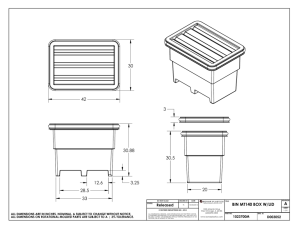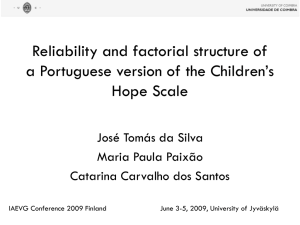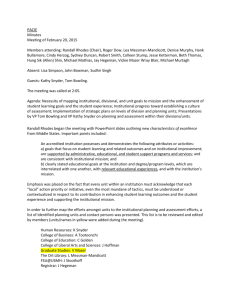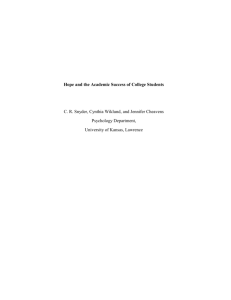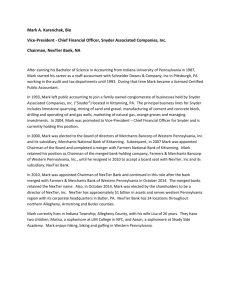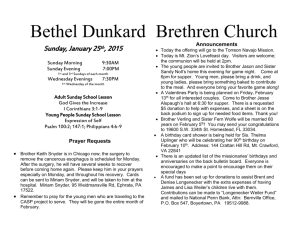hope is defined as “a positive motivational state that is based
advertisement
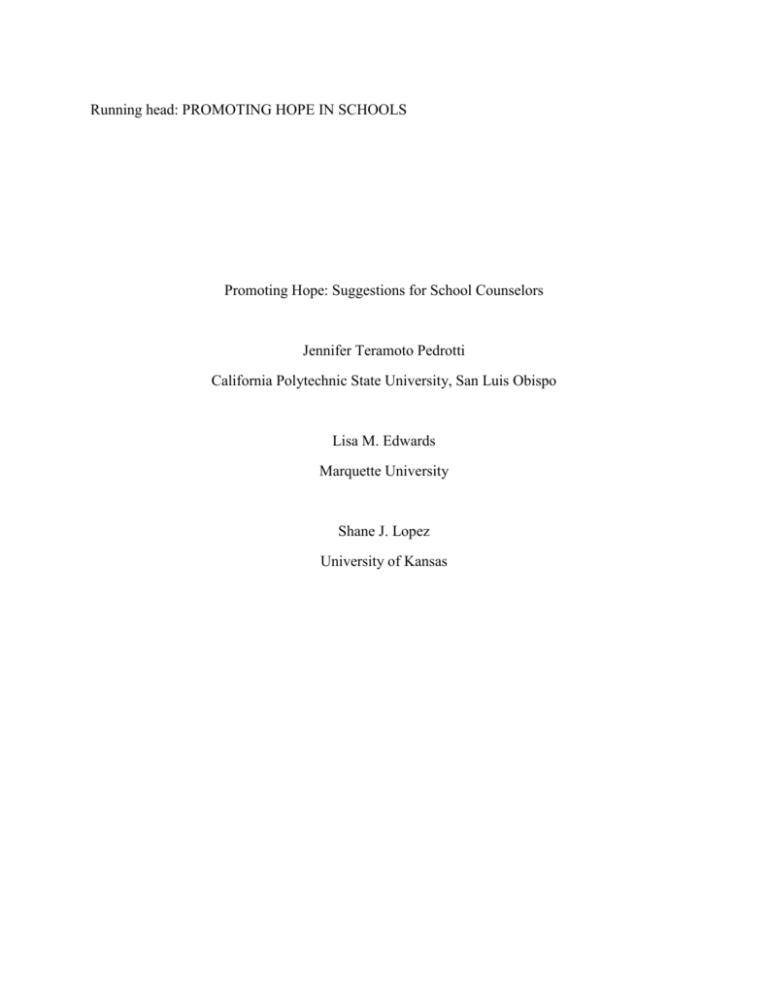
Running head: PROMOTING HOPE IN SCHOOLS Promoting Hope: Suggestions for School Counselors Jennifer Teramoto Pedrotti California Polytechnic State University, San Luis Obispo Lisa M. Edwards Marquette University Shane J. Lopez University of Kansas Hope in Schools 2 Abstract School counselors need multiple resources to assist today’s students in developing to their fullest potential. This development might often be measured outwardly by academic success, however psychological and emotional well-being of students is a large part of this success. The construct of hope is defined as a bidimensional characteristic consisting of an agency component (willpower to move toward one’s goals) and a pathways component (the ability to develop multiple routes to one’s goals) and has been linked to academic success, athletic performance, psychological adjustment, and physical health in students (Snyder et al., 1991). Helping school counselors to enhance individual strengths through the promotion of characteristics such as hope may result in multiple benefits for students and their school environments at large. Studies involving hope and its correlates are discussed and suggestions for appropriate and feasible interventions in this area are given. Hope in Schools 3 Promoting Hope: Suggestions for School Counselors School counselors are uniquely positioned to help students define, work towards, and reach their goals in many life arenas. Though identifying and preventing problems that hinder youth’s success is important, balancing these efforts with a deeper examination of “what works” for students can ultimately reveal individual goals that matter to these students, strategies that can be used to pursue those goals, and the motivation that can keep them on track (Galassi & Akos, 2007). Indeed, using approaches designed to identify and enhance strengths can assist students in achieving to their fullest potential. Hope is conceptualized as a process of goal pursuit involving the generation of multiple routes toward a chosen goal and maintenance of motivational levels needed to make progress along these routes (Snyder et al., 1991). This article will detail Snyder’s hope theory and research, giving special emphasis to the role school counselors can play in enhancing students’ hope and, in turn, the promotion of personal and social well-being, career development, and academic achievement (American School Counselors Association [ASCA], 2005). In thinking about helping students to become more hopeful, it is important to note that that this process involves teaching a set of skills that build on what children do naturally: think about the future. With this strength-based guidance from school counselors, children can learn how to describe important goals that are clear, specific and that add something to their lives. Hope Theory Over the past 20 years, C. R. Snyder and his colleagues have developed a theory and associated measures of hope that have received much attention both within and outside the field of psychology (Edwards, Rand, Lopez, & Snyder, 2006). In his seminal book, The Psychology of Hope (1994), Snyder described his theory and early research efforts to understand and measure hope. He described hope in primarily cognitive terms, though the theory evolved to include emotions as well (Snyder, 2000b). According to Snyder and colleagues (1991, p. 287), hope is defined as “a positive motivational state that is based on an interactively derived sense of successful (a) agency (goal- Hope in Schools 4 directed energy) and (b) pathways (planning to meet goals).” This model involves three interrelated components--goals, agency, and pathways (Snyder, Ilardi, Michael, & Cheavens, 2000). Pathways and agency thinking are positively related, additive and reciprocal, but neither component alone defines hope, nor are they synonymous. Goals are the anchor of hope theory, as they are the targets of mental action sequences (Snyder et al., 2000). Individuals’ goals must fall somewhere in the middle of a probability of an attainment continuum going from goals that are absolutely certain of being achieved to those that are untenable (Edwards et al., 2006). To reach goals, people must perceive that they are capable of imagining one or more routes, or pathways, to their goals. Snyder (1994) described pathways thinking, the second component of hope, as the mental capacity necessary to reach goals. When barriers to desired goals emerge, as they inevitably do, the mental flexibility of pathways thinking allows people to navigate those obstacles and find alternate routes. For example, if a child is learning to play soccer, it might be difficult for her to find time to practice. Pathways thoughts could be those which encourage her to prioritize after school activities, schedule specific practice times with friends, and create a personal system of rewards in order to increase soccer practice time. Agency is the third component of hope, and it refers to the motivation that propels individuals to initiate and sustain movement towards their goals (Snyder, 1994). People with agency, also known as willpower, are able to remain determined and utilize their mental energy to move around obstacles and stay focused on achieving their goals. For the child trying to play soccer better, agency thoughts would be those reminders she tells herself to persist with practicing, focus on improvements, and keep working towards her goal of playing soccer. It is important for school counselors to take cultural context into account, as well, in developing appropriate interventions for students of all backgrounds. In thinking about strengths such as hope as they apply to a diverse population, it is important to be aware of differences in time orientation, value systems, and feasibility of personal choice (Pedrotti, 2007). For example, the hope process, with its future orientation may not fit as well for cultural groups who do not Hope in Schools 5 ascribe to this orientation to time such as Eastern cultures. In addition, individuals from cultures who are more collectivist in nature (e.g., Asian, Latino) may feel that group goals, as opposed to individual, are more pertinent. Finally, sources of agency and motivation may not come from personal stores but may be rooted in familial responsibility, or filial piety (Pedrotti). The hope model may still be used with individuals from these cultures, but at times modifications must be made to ensure relevance and respect for differences. School counselors must be aware of these potential differences in order to appropriately integrate and acknowledge the unique cultural contexts of all students. Hope and its Relationship to Positive Constructs and Outcomes Snyder and colleagues’ (1991) concept of hope has been studied in many contexts and several positive correlates to this construct have been found in youth. Many of these constructs are directly related to goals school counselors may have in developing certain types of strengths in their students. Enhancement of hope within students can assist with development in areas of personal and social, academic, and career development (ASCA, 2005). Hope and Personal/Social Contexts It is not surprising to find that hope is related to many other positive constructs within the realm of personal and social life. Magaletta and Oliver (1999) examined relationships between hope and both self-efficacy and optimism and found positive and statistically significant relationships between these pairs. In addition, hope has been linked with self-esteem (Snyder et al., 1997), self-worth (Curry, Snyder, Cook, Ruby, & Rehm, 1997), beliefs about ability to accomplish goals (Snyder, Sympson, Michael, & Cheavens, 2000), and life satisfaction (Chang, 1998). Studies have also shown that low hope is predictive of depression as well (Kwon, 2000) and higher hope has been found to be related to lower levels of depression in children (Snyder et al., 1997). Hope is termed “a psychological strength” by Valle, Huebner, and Suldo (2006) and was found in their study of adolescents to function as a moderator or buffer between difficult experiences in life and well-being. Finally, Barnum, Snyder, Rapoff, Mani, and Thompson (1998) found that adolescent burn survivors with higher hope related to caregivers more Hope in Schools 6 positively, and also engaged in fewer activities that undermined recovery. Though links between these various constructs and hope are strong, it is important to note that hope, optimism and selfefficacy are uniquely predictive of outcomes and are thus distinct constructs (Magaletta & Oliver). The above constructs are much-desired qualities and can promote social and psychological wellness in all students (Miller, Gilman, & Martens, 2008). Fostering these types of personal traits can have carry-over effects into academic and future work domains as well. Hope and Academic Performance Hope has been linked to academic benefits in several studies. Anderson (1988) found that IQ scores were significantly and positively linked to hope, and Snyder and colleagues (Snyder, 2002; Snyder et al., 1991; Snyder et al., 1997) have studied the relationship between grade point average and hope and found similar results. Hope has also been linked to self-efficacy (Magaletta & Oliver, 1999) and scholastic competence (Onwuegbuzie, 1999), as well as problem-solving (McDermott et al., 2000). Finally, other studies have found that “hope in the future” (as measured by answers to questions regarding the importance of attending college, the likelihood of having a good job by age 30, and the likelihood of having a “dismal” future) is inversely linked dropout rates in adolescents (Worrell & Hale, 2001, p. 378). Hope and Career-Building Skills Positive traits such as hope, self-efficacy, problem-solving and optimism may also assist students in developing good skills in vocational development. Diemer and Bluestein (2007) studied the “vocational hope” (p. 98) of adolescents in urban settings and found that this construct was related to positive vocational identity development. These researchers showed links between the ability to persist toward vocational goals despite various obstacles that may occur. Other studies (e.g., Super, 1980) have shown that a future-oriented identity is positively correlated toward a beneficial vocational identity as well and thus Snyder’s (2002) hope model may be particularly beneficial in this work. Diemer and Bluestein suggest that interventions designed to enhance vocational hope may assist in managing both external and internal threats to Hope in Schools 7 the career development goals of urban adolescents. These practical implications may be extended to include any school-aged child or adolescent dealing with obstacles in this area. The previously discussed studies show that hope is related to many positive constructs and outcomes; thus it follows that cultivating and enhancing hope in youth may improve current and future functioning. Miller and colleagues (2008) state that “educational facilities are ideal settings for providing interventions and prevention programs that promote hope and optimism” (p. 6) due to the large amount of time that students spend in this venue. Thus school counselors are uniquely equipped to help students to build these types of resources and to offer programming to address these topics with both students and parents. Assessment of Hope One of the issues that has plagued research in the areas of wellness and health promotion is the incorrect belief that assessment of positive characteristics, such as hope, well-being, optimism, and others, is impossible due to their amorphous nature (Snyder & Lopez, 2007). There are, in fact, many methods of measurement of these types of constructs. Snyder and colleagues (1991) developed the Adult Hope Scale, a 12-item self-report measure that asks questions related to goal processes. Answers range on a four-point Likert scale from “Definitely False” to “Definitely True.” Psychometrics have been established for this measure (Snyder et al., 1991) and it has been used in hundreds of studies to better understand hope in adults. This measure was then adapted by Snyder and colleagues (1997) to forms that could be used for school-aged children (Children’s Hope Scale; CHS). Snyder, Feldman, Shorey, and Rand (2002) state that in addition to measuring global hope, it is also important to measure domain-specific hope. Some studies have found that while global hope may be high for students, hope in the specific domain of academics may be lacking (Snyder, Feldman, Shorey, & Rand, 2002). Thus, measurement across several levels may be appropriate, and the Domain Specific Hope Scale may be useful for this assessment (Sympson, 1999). The Children’s Hope Scale (CHS; Snyder et al., 1997) is a six-item self-report scale that asks questions about how children think and feel about their goals and the steps they take to Hope in Schools 8 reach them. Answers on this scale range from “None of the Time” to “All of the time” on a sixpoint Likert scale. Three of the six items (items 2, 4, and 6) can be summed to form a “Pathways” subscale (e.g., "I can think of many ways to get the things in life that are most important to me") and the other three (items 1, 3, and 5) sum to form an “Agency” subscale agency (e.g., "I think I am doing pretty well"). A copy of the scale is included in Appendix A. The CHS was developed for use with children ages 7 to 16, and support for reliability and validity, as well as factor structure, has been established in many different populations of youth (Lopez, Snyder, & Pedrotti, 2003). Despite mean-level analyses of race and gender (Snyder et al., 1997; Valle, Huebner, & Suldo, 2004), further basic information is needed to understand hope in other non-European American populations. Support has been found for a hierarchical representation of the CHS with two underlying factors (pathways and agency) within Mexican American youth (Edwards, Ong & Lopez, 2007). CHS scores were found to be positively correlated with measures of positive affect, life satisfaction, support from family and friends, and optimism, and additional analyses provided evidence supporting convergent validity and measurement invariance across gender. In addition, recent investigations of hope in African American youth have provided support for the reliability and validity of the CHS with this population (Valle, Huebner, & Suldo). More information is needed regarding conceptual equivalence of the construct of hope across cultures. The CHS is a well-researched assessment tool that has been used in numerous studies and settings to understand hope in youth (Edwards et al., 2006). School counselors may consider using the CHS in order to chart individual student progress, conduct research about hope and other outcomes in schools, and provide evidence-based support for related interventions that target hope and/or well-being (ASCA, 2005). In addition, once a level of hope has been established for a student or group of youth, school counselors can monitor this level as they teach children about the strategies described in the hope model itself. Hope in Schools 9 Increasing Hope in Youth Individual Strategies School counselors may consider integrating hope concepts into their individual planning work with students (ASCA, 2005). According to Snyder et al. (2002), the first step in engaging youth about hope concepts is to help them identify a set of goals that span various life domains. School counselors can utilize values, interests and skills/abilities inventories to stimulate this list of goals, and students should be encouraged to prioritize the goals in terms of importance to them. Those goals that are unambiguous and have distinct endpoints will be best for students to work towards and markers can be created to help students evaluate their progress towards goals. Once counselors have helped students identify and rank their goals, they can work with youth to develop agency and pathways thoughts (Snyder et al., 2002). Developing agency about goals involves examining the nature of the goals and deciding if they are meaningful and challenging enough to sustain the student’s energy and motivation to pursue them. Additionally, students can be taught to monitor negative self-talk that may be discouraging, and rather focus on learning positive self-statements such as “I can do this” and “I’m a capable person” (Snyder et al., p. 305). Keeping a personal diary of ongoing self-talk can be useful tool for monitoring self statements (Lopez, Rose, Robinson, Marques, & Pais Reibero, in press). Finally, developing pathways thoughts helps students to find routes around obstacles that emerge as they work towards their goals (Snyder et al., 2002). One aspect of enhancing pathways thinking is to develop subgoals which can be approached in a logical, step-by-step sequence (Lopez et al., in press). For example, for a student whose goal is to understand fractions for his math class, a school counselor can help him to identify ways (e.g., finding a peer tutor, completing extra worksheets, etc.) to work towards this goal even as obstacles come in the way. Group Techniques Several promising programs have been developed to enhance hope among children and adolescents, many of which can be utilized or adapted for incorporation into the guidance curriculum (ASCA, 2005). One of the first interventions developed to increase hope in children Hope in Schools 10 involved learning about hope theory and discussing stories about high-hope children (McDermott, Callahan, Gingerich, Hastings, & Gariglietti, 1997). This program involved eight weekly sessions with first through sixth grade students at an ethnically diverse elementary school. During each week of this program, students spent 30 minutes discussing hope and goalsetting and hearing stories about high-hope children. Through hearing and discussing these stories each week for 30 minutes, children had the opportunity to identify goals in the lives of protagonists, as well as to apply the hope concepts to their own lives. Children’s hope was assessed with the CHS before and after the eight-week session, and results demonstrated modest improvement on both self-report and teacher ratings of students’ hope. McDermott and colleagues concluded that an eight-week session was not sufficient time to instill high hope, but they considered their results promising (Lopez et al., 2004). The Making Hope Happen program (MHH; Pedrotti, Lopez, & Krieshok, 2000) is another school-based intervention developed to enhance hope in students through didactic teaching and group work. MHH was first piloted at the junior high level. The MHH program consisted of five 45-minute sessions with groups of 8-10 junior high students, each lead by two graduate students. After beginning with a simple explanation of the hope model developed by Snyder and colleagues (1991), the MHH program was designed to move through various exercises and interactions geared at helping students to use the hope model in their own lives. Week one began with an introduction of the model, using various posters and cartoons to outline the main tenets of pathways, agency, and obstacles. In addition, narratives that featured high-hope protagonists were introduced during this session to help students to identify high-hope strategies and statements. Group discussions were facilitated to outline these points for all students. At the end of this first session, students were paired into “Hope Buddy” partnerships to be kept throughout the five weeks. These pairs were chosen by the researchers after reviewing the students’ individual hope scores and paired high-hope children with lower hope children so as to facilitate modeling. Finally, students were asked to devise a personal goal during this session that could be pursued throughout the five weeks of the MHH program. These goals could Hope in Schools 11 be small or large and did not have to be achieved by the fifth week of the program; the only restriction placed on students was that the goals had to be positive (i.e., adding something to one’s life) as opposed to negative (i.e., stopping a bad behavior or habit). If students devised more negative goals (e.g., “I want to stop fighting with my sister”) group leaders helped them to rework them into a more positive phrasing (e.g., “I want to get along better with my sister”). In week two, the points made during the first session were revisited through the use of new narratives, and the concept of “G-POWER” was introduced. Each of the letters in this word stand for a particular component of the hope model (G = goals; P = pathways; O = obstacles; W = willpower; E = evaluate your process; R = rethink and try again; Pedrotti et al., 2000) and students were trained to use this acronym to help them to remember the different steps to the hope model. Week three followed up on this concept and “The Hope Game” was introduced. This board game was devised to reinforce the additive properties of agency and pathways and to emphasize that both are needed to facilitate goal-achievement. As always after each of these sessions, hope buddies met and discussed progress made on goals throughout the week. In week four, students were given more individual work in addition to group work, and the concept of Hope Talk was introduced during this session. Students were asked to change unhopeful sentences (e.g., “I will never be good at math”) into more hopeful sentences (e.g., “Math is not my best subject, but I can use these strategies to succeed”). In addition, statements from historical (e.g., Martin Luther King, Jr.) and local figures (e.g., college basketball coach) were evaluated by the students for their level of hopefulness. Finally, in this week students began to write their “Personal Hope Story” which described their chosen goal and the progress made toward it during the five weeks, Lastly, in week five students read their completed hope stories to the group. Snacks and beverages were provided on this day to promote a celebration of the completion of progress on these goals and students were asked to offer positive feedback and future steps to each other about their goal processes. Prior to the beginning of the MHH program, all students were given the Children’s Hope Scale (CHS; Snyder et al., 1997). At this time, a control group was also identified and these Hope in Schools 12 students were administered the measure as well. Upon completion of the program all students were again administered the CHS and increases in hope scores were found to be significantly larger in the group of students who participated in the MHH program, as compared to the control group. These results were maintained six weeks post-programming (Pedrotti et al., 2000), suggesting that students continued to utilize the tenets learned in the program. After establishing the Making Hope Happen program at the junior high level, expansion to the elementary school level occurred. Making Hope Happen for Kids (MHHK; Edwards & Lopez, 2000) was developed to enhance hope in fourth grade students. This five-session program involved activities and lessons designed to help students understand hope and apply the construct to their lives. The program was conducted in several classrooms with groups of 7-10 students each led by two graduate student co-facilitators. The first week of MHHK involved learning about the hope model and acting out the parts of the model with laminated props (Edwards & Lopez, 2000). Students pretended to be goals, obstacles, pathways, and agency using the props (e.g., a stop sign for an obstacle, an arrow for pathways and willpower, etc.) in a brief psychodrama depicting meaningful goal pursuits. In the second week, children were introduced to a story that described a young girl navigating obstacles as she worked toward the goal of learning lines for her school play. During the third week, children played a different version of the Hope Game designed for this age group. Children worked in teams to identify obstacles, pathways and agency thoughts to accomplish a shared goal. In the fourth week, children designed hope cartoons, emphasizing hopeful language. Finally, during the last week of the program, children developed hope stories detailing the goals on which they had been working, and then shared their stories with one another in a final celebration. Evaluation of the MHHK program was conducted at the end of the first and second years in two different schools. The CHS (Snyder et al., 1997) was administered before and after delivery of the intervention with all children. While the evaluation of this program did not include a control group, comparisons of means at pre- and post-test demonstrated significant Hope in Schools 13 gains in hope scores in the fourth grade students. Thus, hope was enhanced in these young children (Lopez et al., 2004). In addition, the Making Hope Happen High School (MHH-HS) program was developed specifically for use with freshmen in an urban high school (Bouwkamp & Lopez, 2001). The MHH-HS program, which is quite similar to the original MHH program, consists of five 70minute sessions with groups of 20 plus students, each led by two trained facilitators. As in the other versions of the program, pre-test measures were completed and week one programming began with an introduction of hope theory and its many applications, using various posters and stories (with adolescent high-hope protagonists) to describe how goal thinking combines with pathways and agency. The Hope Camera Project also was introduced during the first week with the following instructions: The “Hope Camera Project” is a creative group effort spanning all five sessions of the program. You will be divided up into groups of ten, and each group will receive a disposable camera. Your instructions are to use the camera and take pictures of people, places, or things that represent HOPE to you. Then you will use these images to create a final HOPE project (of your own design) to share with the class at our fifth session. In weeks two, three, and four, additional hope stories were used to emphasize the components of hope theory and engage participants in the daily applications of hope. Progress on the Hope Camera Projects was discussed. Completion of Personal Hope Stories (see description in junior high version of MHH) reinforced that individuals can pursue important goals without much help from others and the team project helped introduce hope as social phenomenon. Week five took on a celebratory tone with snacks, beverages, and music. Groups shared their Hope Camera Projects, which included collages, power point presentations, a musical number, and one video (which was created by participants who lost their disposable camera and borrowed a video camera to complete the project). The group ended with each participant discussing future plans using hopeful language. Upon completion of the program all students Hope in Schools 14 completed the post-test measures and it was found that low-hope students achieved significant gains in hope (Bouwkamp & Lopez, 2001). Future Directions for Nurturing Hope in Schools As much of children and adolescents’ time is spent in the school environment, “educational facilities are ideal settings for providing interventions and prevention programs that promote hope” (Miller et al., 2008, p. 6). There are several future directions that may be beneficial to pursue in facilitating enhancement of hope within the school environment. School counselors may have a unique vantage point within the school environment to contemplate how to improve hope within students, teachers, staff, and administrators, as well as to note if there are signs of loss of hope or burnout on the part of these personnel (Snyder et al., 2002). Indeed, facilitating systemic change (ASCA, 2005) is an aspect of school counselors’ work that can help to make broader changes in the environments in which youth exist, and may serve to increase hope on a larger scale. School counselors can share information with other school professionals about hope and how to evaluate and increase their own hope within work and personal contexts. Discussions or workshops with school personnel about the general school climate can lead to the generation of specific strategies for facilitating a hopeful environment. To this end, changes must often be facilitated at the macro-level, and recognition of an overarching goal of health and wellness promotion is valuable from an administration perspective (Miller et al., 2008). Encouragement of both physical and mental health in a school’s personnel, and as a goal for its students, can create a climate that values overall wellness in this way. One way to do this is by maximizing mentally healthful characteristics such as hope, as this construct is beneficial on its own, and has so many other positive correlates. Miller and colleagues offer several suggestions along these lines, including incorporating hope and optimism programs within curriculum, use of structured activities outside the curriculum, and applying information from sport and exercise psychology to use within the school context. These researchers state that taking this three-pronged approach that incorporates both psychological and physical health can facilitate overall wellness in students (Miller et al.). Hope in Schools 15 It is also important that school counselors receive support to pursue endeavors that address positive constructs and prevention tactics as opposed to only supporting intervention tactics (Galassi & Akos, 2007). Though it is essential to provide resources for students who are already dealing with problems, primary prevention programs that incorporate all students can be extremely beneficial at promoting positive constructs like hope at a macro-level (Snyder & Lopez, 2007). Meta-analyses have shown that universal primary prevention techniques (i.e., those aimed at an entire community or context) involving programs for children and adolescents have been largely effective (Durlak & Wells, 1997), and thus this is an important area to pursue. Development of programs that create an environment that facilitates respect for diversity is another essential area of future development (Snyder & Lopez, 2007). It is important to recognize that differences may exist between individuals of different races and ethnicities in terms of how they view the relevance of hope in their lives, as well as in the types of pathways they create and the sources from which they derive agency. At present, more research is needed in this area but school counselors can work to develop their own multicultural competence by being aware of their own biases and making sure to gain knowledge and skills in working with individuals from all backgrounds (American Psychological Association, 2002). Finally, several resources exist to help school professionals to learn more about Snyder’s hope model and develop ideas for its application in school and therapeutic contexts. For an academic book on theory and research about hope across various domains, Snyder’s Handbook of Hope (2000), is a critical resource. Other books that provide strategies and examples for how to instill hope in clients and students include: Hope for the Journey: Helping Children through Good Times and Bad, (Cook, McDermott, Rapoff, & Snyder, 1997), Making Hope Happen: A Workbook for Turning Possibilities into Realities (McDermott & Snyder, 1999) and The Great Big Book of Hope (McDermott & Snyder, 2000). It is hoped that through these means school counselors may have the resources they need to assist students and student personnel in enhancing their personal hope. Hope in Schools 16 References American Psychological Association (2002). Guidelines on multicultural education, training, research, practice, and organizational change for psychologists. Washington, DC: Author. American School Counselor Association (2005). The ASCA National Model: A framework for school counseling programs. Herndon, VA: ASCA Publications. Anderson, J. R. (1988). The role of hope in appraisal, goal-setting, expectancy about future success, and coping. Doctoral dissertation, University of Kansas, Lawrence, Kansas. Barnum, D. D., Snyder, C. R., Rapoff, M. A., Mani, M. M., & Thompson, R. (1998). Hope and social support in the psychological adjustment of children who have survived burn injuries and matched controls. Children's Health Care, 27, 15-30. Bouwkamp, J., & Lopez, S. J. (2001). Making Hope Happen: A program for inner-city adolescents. Unpublished masters thesis. University of Kansas, Lawrence, Kansas. Chang, E. C. (1998). Hope, problem-solving ability, and coping in a college student population: Some implications for theory and practice. Journal of Clinical Psychology, 54, 953-962. Cook, W., McDermott, D., Rapoff, M. A., & Snyder, C. R. (1997). Hope for the journey: Helping children through good times and bad. Boulder, CO: Westview. Curry, L. A., Snyder, C. R., Cook, D. L., Ruby, B. C., & Rehm, M. (1997). Role of hope in academic and sport achievement. Journal of Personality and Social psychology, 73, 1257-1267. Diemer, M. A., & Bluestein, D. L. (2007). Vocational hope and vocational identity: Urban adolescents’ career development. Journal of Career Assessment,15, 98-118. Durlak, J. A., & Wells, A. M. (1997). Primary prevention mental health programs for children and adolescents: A meta-analytic review. American Journal of Community Psychology, 25, 115-152. Hope in Schools 17 Edwards, L. M., & Lopez, S. J. (2000). Making Hope Happen for Kids. Unpublished protocol. Edwards, L. M., Ong, A. D., & Lopez, S. J. (2007). Hope measurement in Mexican American youth. Hispanic Journal of Behavioral Sciences, 29, 225-241. Edwards, L. M., Rand, K., Lopez, S. J., & Snyder, C. R. (2006). Understanding hope: A review of measurement and construct validity research. In A. Ong & M. van Dulmen (Eds.), Handbook of Methods in Positive Psychology (pp. 83-95). New York: Oxford Press. Galassi, J., & Akos, P. (2007). Strengths-Based School Counseling: Promoting Student Development and Achievement. Mahwah, MJ: Lawrence Erlbaum Associates. Kwon, P. (2000). Hope and dysphoria: The moderating role of defense mechanisms. Journal of Personality, 68, 199-223. Lopez, S. J., Rose, S., Robinson, C., Marques, S., & Pais Reibero, J. (in press). Measuring and promoting hope in schoolchildren. In R. Gilman, E. S. Huebner, & Furlong, M. (Ed.), Promoting wellness in children and youth: Handbook of positive psychology in the schools. Mahwah, New Jersey: Lawrence Erlbaum. Lopez, S. J., Snyder, C. R., Magyar-Moe, J. L., Edwards, L. M., Pedrotti, J. T., Janowski, K., Turner, J. L., & Pressgrove, C. (2004). Strategies for accentuating hope. In P. A. Linley & S. Joseph (Eds). Positive psychology in practice (pp. 388-404). Hoboken, NJ: John Wiley & Sons. Lopez, S. J., Snyder, C. R., & Pedrotti, J. T. (2003). Hope: Many definitions, many measures. In S. J. Lopez, & C. R. Snyder (Eds.) Positive psychological assessment: A handbook of models and measures. (pp. 91-107). Washington, DC: American Psychological Association. Magaletta, P. R., & Oliver, J. M. (1999). The hope construct, will and ways: Their relations with self-efficacy, optimism, and general well-being. Journal of Clinical Psychology, 55, 539551. Hope in Schools 18 McDermott, D., Callahan, B., Gingerich, K., Hastings, S., & Gariglietti, K. (March, 1997). Working together to bring hope to our children. A presentation at the Kansas Counselors Association annual convention, Hutchinson, KS. McDermott, D., LaRue, S., Spalitto, S. V., Diamond, K. L., Edwards, L. M., Magyar-Moe, J. L., Pedrotti, J. T., & Stone, M. E. (2000, August). Coping with grief and loss: The role of hope and spirituality. Poster session presented at the annual meeting of the American Psychological Association, Washington, DC. McDermott, D., & Snyder, C. R. (1999). Making hope happen. Oakland, CA: New Harbinger. McDermott, D., & Snyder, C. R. (2000). The great big book of hope. Oakland, CA: Harbinger. Miller, D. N., Gilman, R., & Martens, M. P. (2008). Wellness promotion in the schools: Enhancing students’ mental and physical health. Psychology in the Schools, 45, 5-15. Onwuegbuzie, A. J. (1999). Relation of hope to self-perception. Perceptual and Motor Skills, 88, 535-540. Pedrotti, J. T. (2007). Eastern perspectives on positive psychology. In C. R. Snyder, & S. J. Lopez (Eds.) Positive psychology: The scientific and practical explorations of human strengths. Thousand Oaks, CA: Sage. Pedrotti, J. T., Lopez, S. J., & Krieshok, T. S. (2000). Making Hope Happen: A program for fostering strengths in adolescents. Unpublished masters thesis. University of Kansas, Lawrence, Kansas. Snyder, C. R. (1994). The psychology of hope: You can get there from here. New York: Free Press. Snyder, C. R. (Ed.) (2000a). Handbook of hope: Theory, measures, and applications. San Diego, CA: Academic Press. Snyder, C. R. (2000b). The past and future of hope. Journal of Social and Clinical Psychology, 19, 11-28. Snyder, C. R. (2002). Hope theory: Rainbows in the mind. Psychological Inquiry, 13, 249-275. Hope in Schools 19 Snyder, C. R., Feldman, D. B., Shorey, H. S., & Rand, K. L. (2002). Hopeful choices: A school counselor’s guide to hope theory. Professional School Counseling, 5, 298-307. Snyder, C. R., Harris, C., Anderson, J. R., Holleran, S. A., Irving, L. A., Sigmon, S. T., Yoshinobu, L., Gibb, J., Langelle, C., & Harney, P. (1991). The will and the ways: Development and validation of an individual-differences measure of hope. Journal of Personality and Social Psychology, 60, 570-585. Snyder, C. R., Hoza, B., Pelham, W. E., Rapoff, M., Ware, L., Danovsky, M., Highberger, L., Rubinstein, H., & Stahl, K. J. (1997). The development and validation of the Children’s Hope Scale. Journal of Pediatric Psychology, 22, 399-421. Snyder, C. R., Ilardi, S., Michael, S. T., & Cheavens, J. (2000). Hope theory: Updating a common process for psychological change. In C. R. Snyder & R. E. Ingram (Eds.), Handbook of psychological change: Psychotherapy processes and practices for the 21st century (pp. 128-153). New York: John Wiley & Sons, Inc. Snyder, C. R., & Lopez, S. J. (2007). Positive psychology: The scientific and practical explorations of human strengths. Thousand Oaks, CA: Sage. Snyder, C.R., Sympson, S.C., Michael, S.T., & Cheavens, J. (2000). Optimism and hope constructs: Variants on a positive expectancy theme. E.C. Chang (Ed.), Optimism & pessimism: Implications for theory, research, and practice (pp. 101-125). Washington, DC: American Psychological Association. Super, D. E. (1980). A life-span, life-space approach to career development. Journal of Vocational Behavior, 16, 262-298. Sympson, S. (1999). Validation of the Domain Specific Hope Scale. Unpublished doctoral dissertation, Department of Psychology, University of Kansas, Lawrence. Valle, M. F., Huebner, E. S., & Suldo, S. M. (2004). Further evaluation of the children’s hope scale. Journal of Psychoeducational Assessment, 22, 320-337. Valle, M. F., Huebner, E. S., & Suldo, S. M. (2006). An analysis of hope as a psychological strength. Journal of School Psychology, 44, 393-406. Hope in Schools 20 Worrell, F. C., & Hale, R. L. (2001). The relationship of hope in the future and perceived school climate to school completion. School Psychology Quarterly, 16, 370-388. Hope in Schools 21 Goals Scale Directions: Read each item carefully. Using the scale shown below, please select the number that best describes YOU and put that number in the blank provided. 1 2 None of the time A little of the time 3 Some of the time 4 5 A lot of the time Most of the time 6 All of the time _____ 1. I think I am doing pretty well. _____ 2. I can think of many ways to get the things in life that are most important to me. _____ 3. I am doing just as well as other kids my age. _____ 4. When I have a problem, I can come up with lots of ways to solve it. _____ 5. I think the things I have done in the past will help me in the future. _____ 6. Even when others want to quit, I know that I can find ways to solve the problem.
